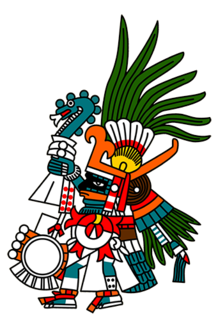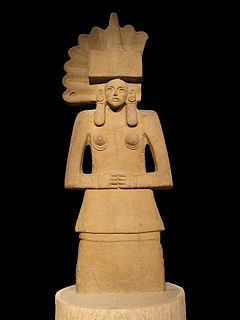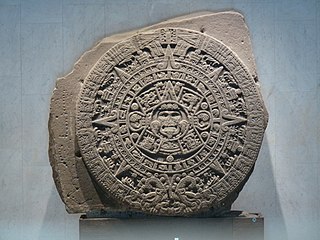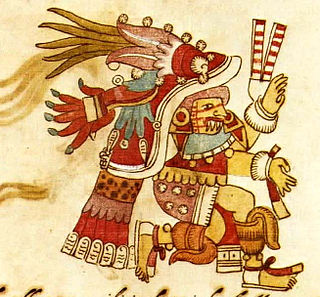
The Aztecs were a Mesoamerican culture that flourished in central Mexico in the post-classic period from 1300 to 1521. The Aztec peoples included different ethnic groups of central Mexico, particularly those groups who spoke the Nahuatl language and who dominated large parts of Mesoamerica from the 14th to the 16th centuries. Aztec culture was organized into city-states (altepetl), some of which joined to form alliances, political confederations, or empires. The Aztec empire was a confederation of three city-states established in 1427, Tenochtitlan, city-state of the Mexica or Tenochca; Texcoco; and Tlacopan, previously part of the Tepanec empire, whose dominant power was Azcapotzalco. Although the term Aztecs is often narrowly restricted to the Mexica of Tenochtitlan, it is also broadly used to refer to Nahua polities or peoples of central Mexico in the prehispanic era, as well as the Spanish colonial era (1521–1821). The definitions of Aztec and Aztecs have long been the topic of scholarly discussion, ever since German scientist Alexander von Humboldt established its common usage in the early nineteenth century.

Chalchiuhtlicue[t͡ʃaːɬt͡ʃiwˈt͡ɬikʷeː] is an Aztec deity of water, rivers, seas, streams, storms, and baptism. Chalchiuhtlicue is associated with fertility and she is the patroness of childbirth. Chalchiuhtlicue was highly revered in Aztec culture at the time of the Spanish conquest and she was an important deity figure in the Postclassic Aztec realm of central Mexico. Chalchiuhtlicue belongs to a larger group of Aztec rain gods and she is closely related to another Aztec water god, Chalchiuhtlatonal.

In the Aztec religion, Huitzilopochtli is a deity of war, sun, human sacrifice, and the patron of the city of Tenochtitlan. He was also the national god of the Mexicas, also known as Aztecs, of Tenochtitlan. Many in the pantheon of deities of the Aztecs were inclined to have a fondness for a particular aspect of warfare. However, Huitzilopochtli was known as the primary god of war in ancient Mexico. Since he was the patron god of the Mexica, he was credited with both the victories and defeats that the Mexica people had on the battlefield. The people had to make sacrifices to him to protect the Aztec from infinite night. He wielded Xiuhcoatl as a weapon, associating him with fire.

In Aztec mythology, Tonacatecuhtli was a creator and fertility god, worshiped for peopling the earth and making it fruitful. Most Colonial-era manuscripts equate him with Ōmetēuctli. His consort was Tonacacihuatl.

In Aztec mythology, a Tzitzimitl[t͡siˈt͡simit͡ɬ] is a deity associated with stars. They were depicted as skeletal female figures wearing skirts often with skull and crossbone designs. In Postconquest descriptions they are often described as "demons" or "devils" - but this does not necessarily reflect their function in the prehispanic belief system of the Aztecs.

The Maya calendar is a system of calendars used in pre-Columbian Mesoamerica and in many modern communities in the Guatemalan highlands, Veracruz, Oaxaca and Chiapas, Mexico.

Tlacaelel I was the principal architect of the Aztec Triple Alliance and hence the Mexica (Aztec) empire. He was the son of Emperor Huitzilihuitl and Queen Cacamacihuatl, nephew of Emperor Itzcoatl, father of poet Macuilxochitzin, and brother of Emperors Chimalpopoca and Moctezuma I.

The tōnalpōhualli, meaning "count of days" in Nahuatl, is an Aztec version of the 260-day calendar in use in pre-Columbian Mesoamerica. This calendar is neither solar nor lunar, but rather consists of 20, 13-day periods. Each trecena is ruled by a different deity.

Toci is a deity figuring prominently in the religion and mythology of the pre-Columbian Aztec civilization of Mesoamerica. In Aztec mythology she is seen as an aspect of the mother goddess Coatlicue, and is thus labeled “mother of the gods”. She is also called Tlalli Iyollo.
Macuiltochtli is one of the five deities from Aztec and other central Mexican pre-Columbian mythological traditions who, known collectively as the Ahuiateteo, symbolized excess, over-indulgence and the attendant punishments and consequences thereof.

Aztec codices are books written by pre-Columbian and colonial-era Nahuas in pictorial and/or alphabetic form. These codices provide some of the best primary sources for Aztec culture. The pre-Columbian codices mostly do not in fact use the codex form and are, or originally were, long folded sheets. These sheets were typically made from stretched deerskin or from the fibers of the agave plant. They also differ from European books in that they mostly consist of images and pictograms; they were not meant to symbolize spoken or written narratives.
Human sacrifice was common to many parts of Mesoamerica. Thus the rite was nothing new to the Aztecs when they arrived at the Valley of Mexico, nor was it something unique to pre-Columbian Mexico. Other Mesoamerican cultures, such as the Purépechas and Toltecs, performed sacrifices as well and from archaeological evidence, it probably existed since the time of the Olmecs, and perhaps even throughout the early farming cultures of the region. Although the extent of human sacrifice is unknown among several Mesoamerican civilizations, such as Teotihuacán, what distinguished Maya and Aztec human sacrifice was the importance with which it was embedded in everyday life.

The Xiuhpōhualli was a 365-day calendar used by the Aztecs and other pre-Columbian Nahua peoples in central Mexico. It was composed of eighteen 20-day "months," called veintenas or mētztli with a separate 5-day period at the end of the year called the nemontemi. Whatever name that was used for these periods in pre-Columbian times is unknown. Through Spanish usage, the 20-day period of the Aztec calendar has become commonly known as a veintena. The Aztec word for moon is mētztli, and this word is today to describe these 20-day periods, although as the sixteenth-century missionary and early ethnographer, Diego Durán explained:
In ancient times the year was composed of eighteen months, and thus it was observed by these Indian people. Since their months were made of no more than twenty days, these were all the days contained in a month, because they were not guided by the moon but by the days; therefore, the year had eighteen months. The days of the year were counted twenty by twenty.

Toxcatl was the name of the fifth twenty-day month or "veintena" of the Aztec calendar which lasted from approximately the 5th to 22 May and of the festival which was held every year in this month. The Festival of Toxcatl was dedicated to the god Tezcatlipoca and featured the sacrifice of a young man who had been impersonating the deity for a full year.

In Aztec religion, Chantico is the deity reigning over the fires in the family hearth. She broke a fast by eating paprika with roasted fish, and was turned into a dog by Tonacatecuhtli as punishment. She was associated with the town of Xochimilco, stonecutters, as well as warriorship. Chantico was described in various Pre-Columbian and colonial codices.
The Aztec New Year is the celebration of the new year according to the Aztec calendar. The date on which the holiday falls in the Gregorian calendar depends on the version of the calendar used, but it is generally considered to occur at sunrise on March 12. The holiday is observed in some Nahua communities in Mexico. To celebrate, ocote (pitch-pine) candles are lit on the eve of the new year, along with fireworks, drumming, and singing. Some of the most important events occur in Huauchinango, Naupan, Mexico City, Zongolica, and Xicotepec.
In the Aztec culture, the Nahuatl word nēmontēmi refers to a period of five intercalary days inserted between years of the Aztec calendar. Each of the 18 Aztec "months" had 20 days, for a total of 360 days. The nēmontēmi accounted for the remaining 5 days of the approximate tropical year. According to the research by R. C. Tunnicliffe, the Aztecs dealt with the remaining fractional-day discrepancy with the true tropical year length by adding a trecena after each bundle of 52 years; these 13 days were not considered unlucky, but they were not characterized by the features of the Aztec calendar.















